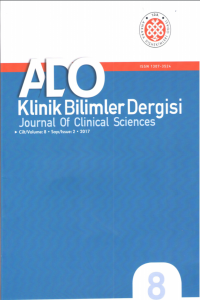Erozyona Bağlı Diş Yüzeyi Kayıplarında Rezin İnfiltrasyon Tekniği Uygulanması: İn-Vitro Çalışma
Diş erozyon, Maskeleme, Rezin infiltrasyon tekniği
Application of Resin Infiltration Technique in the Treatment of Tooth Surface Losses Due to Erosion: In-Vitro Study
Masking, Resin infiltration technique, Tooth erosion,
___
- 1.Jensdottir T, Holbrook P, Nauntofte B, Buchwald C, Bardow A. Immediate Erosive Potential of Cola Drinks and Orange Juices. J Dent Res 2006;85(3):226–30.
- 2.Ritter AV, Boushell LW, Walter R. Sturdevant's Art and Science of Operative Dentistry. 7th ed. St. Louis, Missouri: Elsevier Mosby; 2019. p. 307-44.
- 3.Zafar MS, Ahmed N. Nanomechanical Characterization of Exfoliated and Retained Deciduous İncisors. Technol Health Care 2014;22(6):785–93.
- 4.Grewal N, Gumber S, Kaur N. Comparative Evaluation of Enamel Remineralization Potential of Processed Cheese, Calciumphosphate-based Synthetic agent and a Fluoride-Containing Toothpaste: An in situ study. J Indian Soc Pedod Prev Dent 2017;35(1):19-27.
- 5.Paris S, Meyer-Lueckel H, Kielbassa AM. Resin infiltration of natural caries lesions. J Dent Res 2007;86(7):662-6.
- 6.Araújo GS, Naufel FS, Alonso RC, Lima DA, Puppin-Rontani RM. Influence of Staining Solution and Bleaching on Color Stability of Resin Used for Caries Infiltration. Oper Dent 2015;40(6):E250-E256.
- 7.Horuztepe SA, Ergin E, Gürgan S. Beyaz nokta lezyonlarının giderilmesinde yeni bir yöntem, rezin infiltrasyon tekniği: olgu bildirimi. Acta Odontol Turcica 2015;32(3):153-7.
- 8.Ozgul BM, Orhan K, Oz FT. Micro-computed tomographic analysis of progression of artificial enamel lesions in primary and permanent teeth after resin infiltration. J Oral Sci 2015;57(3):177-83.
- 9.Paris S, Bitter K, Krois J, Meyer-Lueckel H. Seven-year-efficacy of proximal caries infiltration-Randomized clinical trial. J Dent 2020;93:103277.
- 10.Gözetici B, Öztürk-Bozkurt F, Toz-Akalın T. Comparative Evaluation of Resin Infiltration and Remineralisation of Noncavitated Smooth Surface Caries Lesions: 6-month Results. Oral Health Prev Dent 2019;17(2):99-106.
- 11.Anauate-Netto C, Borelli L Neto, Amore R, DI Hipólito V, D'Alpino PHP. Caries progression in non-cavitated fissures after infiltrant application: a 3-year follow-up of a randomized controlled clinical trial. J Appl Oral Sci 2017;25(4):442-54.
- 12.Eckstein A, Helms HJ, Knösel M. Camouflage effects following resin infiltration of postorthodontic white-spot lesions in vivo: One-year follow-up. Angle Orthod 2015;85(3):374-80.
- 13.Hammad SM, Enan ET. In vivo effects of two acidic soft drinks on shear bond strength of metal orthodontic brackets with and without resin infiltration treatment. Angle Orthod 2013;83(4):648-52.
- 14.Arthur RA, Zenkner JE, d'Ornellas Pereira Júnior JC, Correia RT, Alves LS, Maltz M. Proximal carious lesions infiltration-a 3-year follow-up study of a randomized controlled clinical trial. Clin Oral Investig 2018;22(1):469-74.
- 15.Lee J, Okoye LO, Lima PP, Gakunga PT, Amaechi BT. Investigation of the esthetic outcomes of white spot lesion treatments. Niger J Clin Pract. 2020;23(9):1312-7.
- 16.Arjun DS, Bhat SS, Hegde SK, Bhat VS, Rao HTA, Ramdas SS. Comparative Evaluation of Two Remineralizing Agents on Artificial Carious Lesion Using DIAGNOdent. Int J Clin Pediatr Dent 2021;14(2):192-5.
- 17.Choi YY, Lee DY, Kim YJ. Colorimetric evaluation of white spot lesions following external bleaching with fluoridation: An in-vitro study. Korean J Orthod. 2018;48(6):377-83.
- 18.Hallgren K, Akyalcın S, English J, Tufekci E, Paravina RD. Color Properties of Demineralized Enamel Surfaces Treated with a Resin Inf|ltration System. JERD 2016;28(5):339-46.
- 19.de Oliveira Correia AM, Bühler Borges A, Torres CRG. Color masking prediction of posterior white spot lesions by resin infiltration in vitro. J Dent 2020;95:103308.
- 20.Garg SA, Chavda SM. Color Masking White Fluorotic Spots by Resin Infiltration and Its Quantitation by Computerized Photographic Analysis: A 12-month Follow-up Study. Oper Dent 2020;45(1):1-9.
- 21.Jansen EE, Meyer-Lueckel H, Esteves-Oliveira M, Wierichs RJ. Do bleaching gels affect the stability of the masking and caries-arresting effects of caries infiltration-in vitro. Clin Oral Investig. 2021;25(6):4011-21.
- 22.Paris S, Schwendicke F, Keltsch J, Dorfer C, Meyer-Lueckel H. Masking of white spot lesions by resin infiltration in vitro. J Dent 2013;41(Suppl 5):e28–e34.
- 23.Knosel M, Eckstein A, Helms HJ. Long-term follow-up of camouflage effects following resin infiltration of post orthodontic white-spot lesions in vivo. Angle Orthod 2019;89:33–9.
- 24.Kobbe C, Fritz U, Wierichs RJ, Meyer-Lueckel H. Evaluation of the value of re-wetting prior to resin infiltration of post-orthodontic caries lesions. J Dent 2019;91:103243.
- 25.Andrade RMPM, Lima TO, Menezes-Oliveira MA, Nogueira R, Lepri CP, Geraldo-Martins V. Clinical evaluation of the immediate masking effect of enamel white spot lesions treated with an infiltrant resin. Int J Esthet Dent 2020;15(3):306-16.
- ISSN: 1307-3540
- Yayın Aralığı: Yılda 3 Sayı
- Başlangıç: 2006
- Yayıncı: Ankara Diş Hekimleri Odası
Ceren TURHANLI, Sıla Çağrı İŞLER
Mandibulada Lokalize Geniş Bilateral Mandibular Torusun Eksizyonu: Vaka Sunumu
Elif Betül YILDIRIM, Turan KAZAN, Yeliz KILINÇ
ProTaper Next Eğelerin Farklı Tork Değerlerinin Mikroçatlak Oluşumuna Etkisi
Ecehan HAZAR, Baran Can SAĞLAM, Murat KOCAK, Sibel TAZEGÜL-KOCAK
Kısmi Dişsiz Hastanın İmplant-Diş Bağlantılı Sabit Bölümlü Protezle Restorasyonu: Olgu Sunumu
Aykut GÖNDER, Elif Didem DEMİRDAĞ, Emine Hülya DEMİR SEVİNÇ, Serdar POLAT
Mandibular kanalın az bilinen çok görülen anatomik varyasyonu: Bifid mandibular kanal
Cevahir CENGİZ, Sara SAMUR ERGÜVEN
BİR GRUP FARKLI SOSYOEKONOMİK DÜZEYDEKİ ÇOCUKLARIN DENTAL ANKSİYETELERİNİN DEĞERLENDİRİLMESİ
Betül ŞEN YAVUZ, Esra BAYRAM, Betul KARGUL
Çürük Kontrolünde Minimal İnvaziv Bir Yaklaşım: Nano Silver Florür Uygulaması
KONİK IŞINLI BİLGİSAYARLI TOMOGRAFİ GÖRÜNTÜLERİNDE RASTLANTISAL BULGULAR: BİR KESİTSEL ARAŞTIRMA
Mehmet Özgür ÖZEMRE, Nazan KOCAK TOPBAS, Hazal KARSLIOĞLU, Cansu KÖSEOĞLU SEÇGİN, Kaan ORHAN
Hasta başı CAD-CAM Uygulamaları
Ceyda Başak İNAL, Merve BANKOĞLU GÜNGÖR, Seçil KARAKOCA NEMLİ
